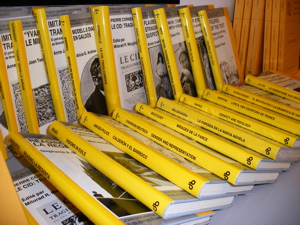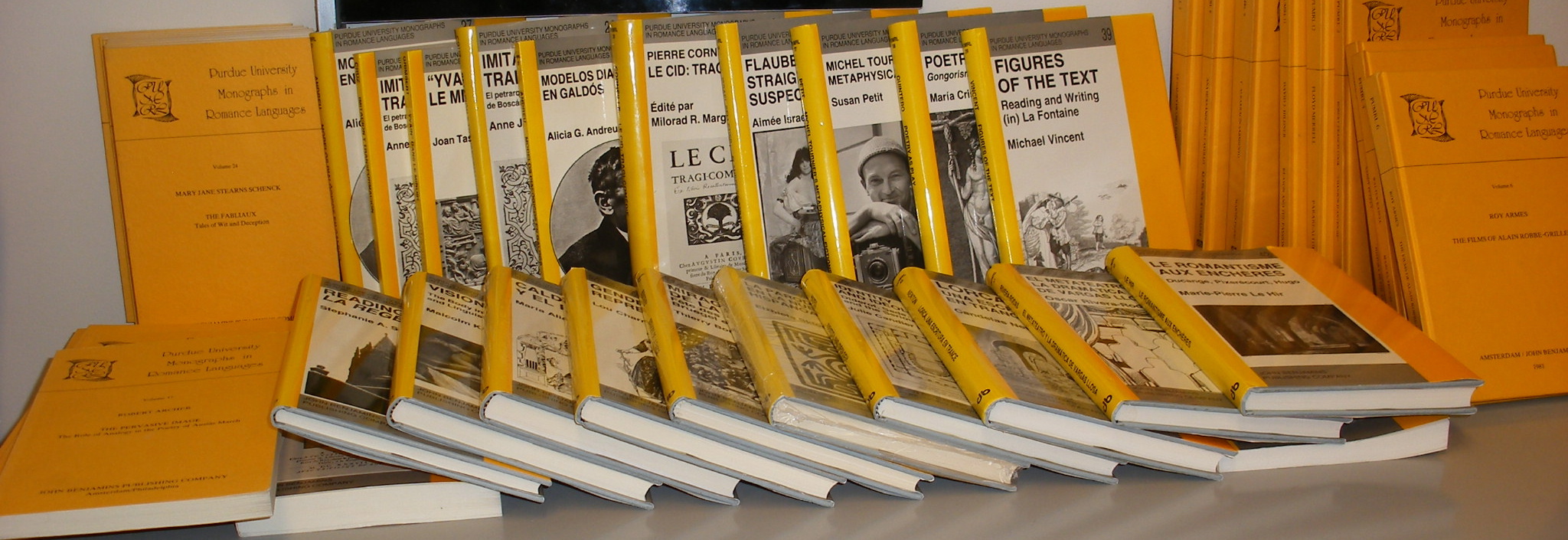
PUMRL Reviews
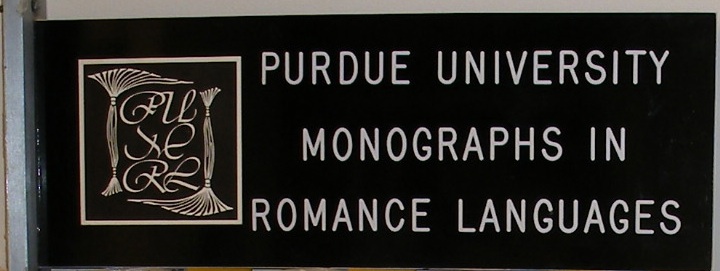 The volumes of Purdue University Monographs in Romance Languages were published from 1980 to 1992 by John Benjamins of Amsterdam and Philadelphia. When the series moved to Purdue University Press the name was changed to Purdue Studies in Romance Literatures (PSRL).
The volumes of Purdue University Monographs in Romance Languages were published from 1980 to 1992 by John Benjamins of Amsterdam and Philadelphia. When the series moved to Purdue University Press the name was changed to Purdue Studies in Romance Literatures (PSRL).
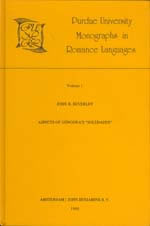 1. John R. Beverley: Aspects of Góngora’s "Soledades." Amsterdam: Benjamins, 1980. xiv, 139 pp. Cloth.
1. John R. Beverley: Aspects of Góngora’s "Soledades." Amsterdam: Benjamins, 1980. xiv, 139 pp. Cloth.
"No future reader of the Soledades can ignore this densely suggestive and literarily sensitive little book, which contains a wealth of specific new insights into individual passages of the poem."—Elias L. Rivers, MLN 98.2 (Mar. 1983): 291-94.
". . . sets forth a compelling and convincingly fresh interpretation of Góngora’s Soledades and, in so doing, enacts the virtues of sociocritical theory in rewarding fashion. . . . A reading of Aspects of Góngora’s‘Soledades’ is a must for specialists."—Thomas E. Lewis, Poetics Today 3.2 (1982): 183-85.
For more reviews, see
Bulletin of Hispanic Studies 58.4 (Oct. 1981): 350-51. (J. F. G. Gornall)
Hispanic Journal 2.1 (Fall 1980): 129.
Year's Work in Modern Language Studies 42 (1980): 294.
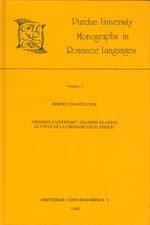 2. Robert Francis Cook: "Chanson d’Antioche," chanson de geste: Le Cycle de la Croisade est-il épique? Amsterdam: Benjamins, 1980. viii, 107 pp. Cloth.
2. Robert Francis Cook: "Chanson d’Antioche," chanson de geste: Le Cycle de la Croisade est-il épique? Amsterdam: Benjamins, 1980. viii, 107 pp. Cloth.
"Its fresh and often ingenious insights make it an indispensable tool for scholars of early Crusade history and literature."—Lewis A. M. Sumberg,Speculum 57.2 (Apr. 1982): 363-65.
"An example to scholars of Old French of how to make a convincing case for little-known works."—Keith Busby, Romanische Forschungen 95.3 (1983): 335-37.
"Nous n’hésitons pas à dire que la démonstration du Professeur Cook est des plus convaincantes."—Guy R. Mermier, French Review 56.6 (May 1983): 937-38.
"an indispensable tool"
—Lewis A. M. Sumberg,
Speculum
For more reviews, see
Romance Philology 39.2 (Nov. 1985): 256-58. (Philippe Ménard)
Medium AEvum 52.2 (1983): 322-23. (D. D. R. Owen)
Modern Language Review (Nov. 1983): 917-18. (Tony Hunt)
Cahiers de Civilisation Mediévale 27.1/2, fasc. 105/06 (May 1984): 165-66. (Jeanne Lods)
Zeitschrift für Romanische Philologie 99.3/4 (1983): 404-06. (Hermann Kleber)
Year's Work in Modern Language Studies 42 (1980): 55.
Forum for Modern Language Studies 19.3 (July 1983): 285.
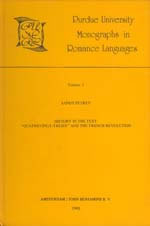 3. Sandy Petrey: History in the Text: "Quatrevingt-Treize" and the French Revolution. Amsterdam: Benjamins, 1980. viii, 129 pp. Cloth.
3. Sandy Petrey: History in the Text: "Quatrevingt-Treize" and the French Revolution. Amsterdam: Benjamins, 1980. viii, 129 pp. Cloth.
". . . well thought out, lucidly expounded, and indeed often brilliant. Any serious student of Victor Hugo will profit enormously from reading it."—Richard B. Grant, Nineteenth-Century French Studies 10.1-2 (Fall-Winter 1981-82): 144-45.
". . . the most satisfying full-length critical appraisal that I have encountered of Quatrevingt-Treize."—Robert T. Denommé, MLN 97.4 (May 1982): 1006-08.
" . . . vivement mené, stimulant, soulève à tout moment des questions importantes. . . . "—Victor Brombert, Revue d’Histoire Littéraire de la France 82.5-6 (Sept./Dec. 1982): 925-26.
For more reviews, see
French Review 56.2 (Dec. 1982): 323-24. (Michel Grimaud)
Studi Francesi 25.75 (Sept. -Dec. 1981): 572-73. (Carlo Cordié)
French Studies 37.2 (Apr. 1983): 230. (David M. Bickerton)
French Forum 7.1 (Jan. 1982): 84-85. (Naomi Schor)
Modern Language Review 77, Part 1 (Jan. 1982): 212-13. (David Bellos)
Year's Work in Modern Language Studies 42 (1980): 192.
Forum for Modern Language Studies 18.4 (Oct. 1982): 375.
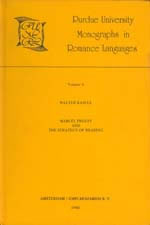 4. Walter Kasell: Marcel Proust and the Strategy of Reading. Amsterdam: Benjamins, 1980. x,125 pp. Cloth.
4. Walter Kasell: Marcel Proust and the Strategy of Reading. Amsterdam: Benjamins, 1980. x,125 pp. Cloth.
"This interesting addition to a carefully-edited new monograph series makes several contributions to Proust studies."—Laurence M. Porter,L’Esprit Créateur 21.2 (Summer 1981): 100-01.
"C’est une étude élégante, très bien présentée. . . . Plein d’observations ingénieuses et pénétrantes. . . ."—Jane Robertson, Bulletin des Amis de Marcel Proust No. 32 (1982): 580-81.
". . . a provocative and valuable book."—Michel Grimaud, French Review56.3 (Feb. 1983): 490-91.
For more reviews, see
French Forum 7.1 (Jan. 1982): 86-88. (J. E. Rivers)
Romanische Forschungen 96.1/2 (1984): 197-98. (Angelika Corgineau-Hoffmann)
Modern Language Review (Nov. 1983): 930-31. (Valerie Minogue)
Proust Research Association Newsletter 23 (Summer 1982): 65.
Year's Work in Modern Language Studies 42 (1980): 236-37.
Forum for Modern Language Studies 18.4 (Oct. 1982): 373.
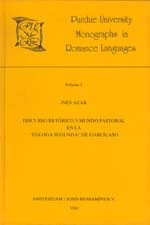 5. Inés Azar: Discurso retórico y mundo pastoral en la "Egloga segunda" de Garcilaso. Amsterdam: Benjamins, 1981. x, 171 pp. Cloth.
5. Inés Azar: Discurso retórico y mundo pastoral en la "Egloga segunda" de Garcilaso. Amsterdam: Benjamins, 1981. x, 171 pp. Cloth.
"This is a meticulous and serious study of the Second Eclogue that takes account of previous criticism as it searches for the meaning of the poem through its structure and formal symmetry. . . . a coherent and stimulating interpretation. . . . "—Forum for Modern Language Studies 19.1 (Jan. 1983): 90.
"A new approach to Garcilaso, this book complements studies . . . which pull together the themes of the poem as an intellectual construct but leave aside questions of language."—Michael L. Perna, MLN 98.2 (Mar. 1983): 289-91).
"El análisis retórico de la ‘Egloga segunda,’ de Garcilaso, llevado con rigor y detalle, es convincente."—Antonio Carreño, Revista de Literatura 46.91 (1984): 194-96.
For more reviews, see
Romanische Forschungen 96.1/2 (1984): 212-14. (Ivy A. Corfis)
Hispanic Review 52 (Spring 1984): 235-37. (Darío Fernández-Morera)
Bulletin of Hispanic Studies 60.2 (Apr. 1983): 144. (J. F. G. Gornall)
Journal of Hispanic Philology 7.1 (1982): 67-69. (Pamela Waley)
Year's Work in Modern Language Studies 43 (1981): 317.
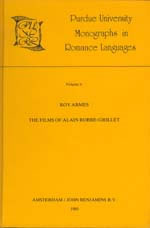 6. Roy Armes: The Films of Alain Robbe-Grillet. Amsterdam: Benjamins, 1981. x, 216 pp. Cloth.
6. Roy Armes: The Films of Alain Robbe-Grillet. Amsterdam: Benjamins, 1981. x, 216 pp. Cloth.
"Roy Armes masterfully delivers a dossier cum critique of R-G as film-maker in this volume of the intelligently academic series, Purdue University Monographs. . . . an excellent reference work."—Karen Jaehne, Film Quarterly 36 (Summer 1983): 39-40.
"Armes’s analysis is formally fascinating and rigorous . . . and particularly stimulating when it relates recurrent themes or individual scenes in the films not only to other Robbe-Grillet films, but also to episodes from the novels as far back as Les Gommes."—Keith Reader, French Studies 37.3 (July 1983): 368-69.
For more reviews, see
French Review 57.4 (Mar. 1984): 570-72.
Critical Texts (Nov. 1982?): 52-54. (Leonard Orr)
Forum for Modern Language Studies 18.2 (Apr. 1982): 183.
Year's Work in Modern Language Studies 43 (1981): 258.
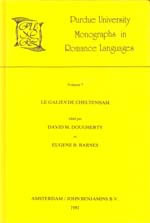 7. David M. Dougherty and Eugene B. Barnes, eds.: Le "Galien" de Cheltenham. Amsterdam: Benjamins, 1981. xxxvi, 203 pp. Cloth.
7. David M. Dougherty and Eugene B. Barnes, eds.: Le "Galien" de Cheltenham. Amsterdam: Benjamins, 1981. xxxvi, 203 pp. Cloth.
"[In this edition, the text,] cleanly and conservatively presented, . . . offers us the possibility of approaching the work itself, without dealing with Stengel’s innovations [in his edition of 1890.] . . . For making it available to us the editors deserve our gratitude."—Norris J. Lacy, French Review 56.5 (Apr. 1983): 764.
"Gli editori cercano qui di dimostrare come il Galien sia un’opera letteraria più importante di quanto l’edizione dello Stengel non abbia fatto credere. . . . Non soltanto si tratta de una nuova edizione, ma di uno spirito nuovo." —R. Bracchi, Salesianum 46 (1984): 321-22.
Mor more reviews, see
Romance Philology 38.4 (May 1985): 537-42. (Peter F. Dembowski)
French Studies 39.2 (Apr. 1985): 181-82. (W. G. van Emden)
Medium AEvum 52.2 (1983): 323. (D. D. R. Owen)
Cahiers de Civilisation Mediévale 27.4, fasc. 108 (Dec. 1984):374-77 (Claude Régnier)
Modern Language Review (Nov. 1983): 918-19. (P. E. Bennett)
Speculum 58 (1983): 1033-35. (William W. Kibler)
Zeitschrift für Romanische Philologie 100.1/2 (1984): 191-93. (Gilles Roques)
Studi Medievali, 3rd Seriesn Anno 24, Fasc. 2 (Dec. 1983): 965-66. (Gaetano Pacione)
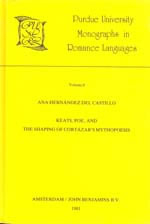 8. Ana Hernández del Castillo: Keats, Poe, and the Shaping of Cortázar’s Mythopoesis. Amsterdam: Benjamins, 1981. xii, 135 pp. Cloth.
8. Ana Hernández del Castillo: Keats, Poe, and the Shaping of Cortázar’s Mythopoesis. Amsterdam: Benjamins, 1981. xii, 135 pp. Cloth.
"El estudio de Ana Hernández del Castillo revela, por un lado, un conocimiento exhaustivo de la obra de los tres autores—y en particular de la de Cortázar—mientras que por otro, al abordar un tema dificilísimo, el de las ‘influencias,’ lo hace con una nitidez, una profundidad y una comunicabilidad pocas veces alcanzadas."—Rose S. Minc, Chasqui 11.2-3 (Feb.-May 1982): 75-76.
"[T]his comparative study. . . should be one of the very prime items in any selected bibliography of criticism on Julio Cortázar."—Steven Boldy, Revista Canadiense de Estudios Hispánicos 9.2 (Winter 1985): 271-74.
"Hernández marshalls her evidence well."—Wendy B. Faris, Comparative Literature 36.3 (Summer 1984): 285-87.
For more reviews, see
World Literature Today, Winter 1983. (Mary E. Davis)
Canadian Review of Comparative Literature 16 (Mar.-Jan. 1989): 494-96. (Richard A. Young)
Bulletin of Hispanic Studies 61.1 (Jan. 1984): 57-58. (Peter Standish)
Year's Work in Modern Language Studies 44 (1982): 497.
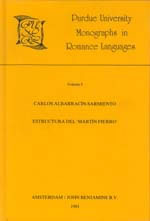 9. Carlos Albarracín-Sarmiento: Estructura del "Martín Fierro." Amsterdam: Benjamins, 1981. xx, 336 pp. Cloth.
9. Carlos Albarracín-Sarmiento: Estructura del "Martín Fierro." Amsterdam: Benjamins, 1981. xx, 336 pp. Cloth.
". . . the most extended and thorough analysis of the purely literary and artistic aspects of Martín Fierro that has ever been done. . . . [T]his study embraces not only the structure of the work in the broadest sense of that term, but includes stylistic, narrative, and metaphorical components as well. . . . [A] serious and very competent study, which merits my recommendation to all those who want a fuller comprehension of one of Hispanic America’s most engaging works."—Myron L. Lichtblau, Hispanic Review 52 (Spring 1984): 252-54.
For more reviews, see
Bulletin of Hispanic Studies 61.2 (Apr. 1984): 211-12. (Peter R. Beardsell)
Chasqui 12.2/3 (Feb.-Mar. 1983): 84-85. (David William Foster)
Year's Work in Modern Language Studies 45 (1983): 418.
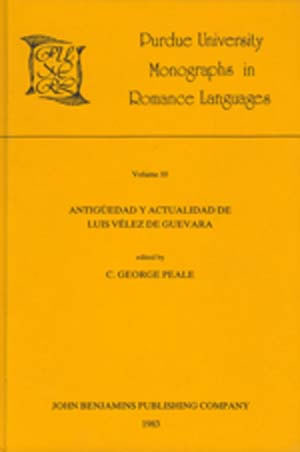 10. C. George Peale, ed.: Antigüedad y actualidad de Luis Vélez de Guevara: Estudios críticos. Amsterdam/Philadelphia: Benjamins, 1983. xii, 298 pp. Cloth.
10. C. George Peale, ed.: Antigüedad y actualidad de Luis Vélez de Guevara: Estudios críticos. Amsterdam/Philadelphia: Benjamins, 1983. xii, 298 pp. Cloth.
". . . the qualifications of its contributors are beyond reproach. Their diverse approaches and methodologies are informative and refreshing. . . . Not many collections of this sort succeed in changing the views of critics or the fate of authors they deal with, but I suspect that this one will. It deserves to be read carefully by critics of Golden Age literature."—Robert L. Fiore, Romance Quarterly 33 (1986): 497-98. (Robert L. Fiore)
". . . includes significant contributions which go beyond the immediate context and which should be of interest to those who are not velecistas."—Bernard P. E. Bentley, Modern Language Review 81.3 (July 1986): 771.
" . . . thoroughly covers a long-neglected Spanish dramatist and his relationship to his era. . . . This book, no doubt, will influence critical study on many of the other lesser-known Spanish dramatists."—Henryk Ziomek,Bulletin of the Comediantes 36.2 (Winter 1984): 211-13.
"All in all, this collection of studies contains some important material and bears out the claim of its editor that it marks an important further stage of the revaluation of Vélez de Guevara."—A. A. Heathcote, Bulletin of Hispanic Studies 63.3 (July 1986): 289-90.
"marks an important further
stage of the revaluation
of Vélez de Guevara"
—A. A. Heathcote,
Bulletin of Hispanic Studies
For further reviews, see
Journal of Hispanic Philology 8.1 (Fall 1983): 89.
Hispania 69 (Mar. 1986): 100-01.
Year's Work in Modern Language Studies 45 (1983): 324.
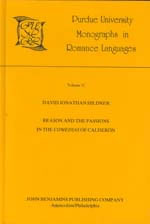 11. David Jonathan Hildner: Reason and the Passions in the "Comedias" of Calderón. Amsterdam/Philadelphia: Benjamins, 1982. xii, 119 pp. Cloth.
11. David Jonathan Hildner: Reason and the Passions in the "Comedias" of Calderón. Amsterdam/Philadelphia: Benjamins, 1982. xii, 119 pp. Cloth.
"He presents a more complex and ambiguous Calderón. . . . This view . . . is supported by sensitive analyses of passages from the plays as dramatic representations and intellectual constructs of rhetorical beauty."—Forum for Modern Language Studies 20.3 (July 1984): 283.
"In his presentation of Calderón as a dramatist whose Weltanschauung is richly endowed with passion, as well as with reason, Hildner is convincing in identifying aspects of Calderón’s dramaturgy which show him to be much more than the playwright traditionally portrayed. . . . " —James A. Castañeda, Revista de Estudios Hispánicos 21.1 (May 1987): 117-18."...he has a sharp, original eye and can be very judicious in his critical assessments."—Melveena McKendrick, Bulletin of Hispanic Studies 62.4 (Oct. 1985): 395-96.
For more reviews, see
Bulletin of the Comediantes 35.2 (Winter 1983): 220-22. (Deborah J. Hill)
Journal of Hispanic Philology 9.1 (Fall 1984): 89-92. (Stephen H. Lipmann)
Revista Canadiense de Estudios Hispanicos 11.3 (Spring 1988): 505-07. (J.M. Ruano de la Haza)
Year's Work in Modern Language Studies 45 (1983): 327-28.
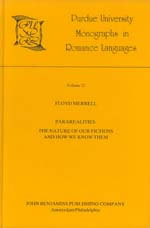 12. Floyd Merrell: Pararealities: The Nature of Our Fictions and How We Know Them. Amsterdam/Philadelphia: Benjamins, 1983. xii, 170 pp. Cloth.
12. Floyd Merrell: Pararealities: The Nature of Our Fictions and How We Know Them. Amsterdam/Philadelphia: Benjamins, 1983. xii, 170 pp. Cloth.
"Many of us who attempt to work out the implications of the great Wittgenstein’s ideas tend to babble mere nonsense. Floyd Merrell is a notable exception. He understands modern thought. . . . Merrell provides in Pararealities an excellent introduction to the question of the role of fictions in human culture considered broadly."—Eugene Hollahan, Modern Fiction Studies 30.2 (Summer 1984): 413-15.
"The presentation is clear and methodical. . . . The subject is fascinating and the author well documented. . . . Pararealities is a refreshingly honest attempt to discuss, tabula rasa, our fictions, and is a stimulating discussion of how we create and know them."—Anna Whiteside, Canadian Review of Comparative Literature 14.2 (June 1987): 257-59.
"a stimulating discussion"
—Anna Whiteside,
Canadian Review of Comparative Literature
For more reviews, see
Poetics Today 9.4 (1988): 863-78. (Uri Margolin)
Journal of Aesthetics and Art Criticism, Fall 1983.
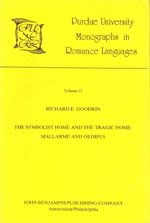 13. Richard E. Goodkin: The Symbolist Home and the Tragic Home: Mallarmé and Oedipus. Amsterdam/Philadelphia: Benjamins, 1984. xvi, 203 pp. Paper.
13. Richard E. Goodkin: The Symbolist Home and the Tragic Home: Mallarmé and Oedipus. Amsterdam/Philadelphia: Benjamins, 1984. xvi, 203 pp. Paper.
". . . absolutely stunning: intelligent, perceptive, well written. The chapters on Oedipus are fascinating: those on Mallarmé are among the best I have ever read. The Mallarmé exegeses are daring, ingenious, and always alert."—Robert L. Mitchell
"The readings of [Mallarmé’s sonnets] are uniformly subtle. . . . Goodkin is perfectly at home in French and is also an accomplished Hellenist and Latinist. . . . This book should be read by serious students of Mallarmé. . . ." —Marshall C. Olds, French Forum 11.1 (Jan. 1986): 120-21.
". . . these analyses untie numerous knotty problems, and Goodkin’s contagious delight and undoubted skill in close reading illuminate these six poems ‘ainsi qu’une joyeuse et tutélaire torche.’"—Rosemary Lloyd, French Studies 40.2 (Apr. 1986): 229-30.
For more reviews, see
Modern Language Review 81.2 (Apr. 1986): 490-91. (C. Chadwick)
Nineteenth-Century French Studies 14.3-4 (Spring-Summer 1986): 370-72. (Carol de Dobay Rifelj)
Romance Quarterly 34 (1987): 502-03. (Peter Collier)
Studi Francesi 30.1 (No. 88) (1986): 164. (François Bruzzo)
Revue d’Histoire Littéraire de la France No. 2 (1987): 328. (Hans Peter Lund)
French Review 61.3 (Feb. 1988): 477-78. (Francis S. Heck)
Literary Research / Recherche littéraire No. 13 (Winter 1989-90): 18-19. (Marie Gagné)
Year's Work in Modern Language Studies 47 (1985): 203.
Forum for Modern Language Studies 22.1 (Jan. 1986): 84.
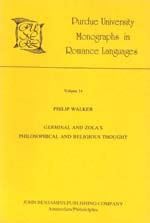 14. Philip Walker: "Germinal" and Zola’s Philosophical and Religious Thought.Amsterdam/Philadelphia: Benjamins, 1984. xii, 157 pp. Paper.
14. Philip Walker: "Germinal" and Zola’s Philosophical and Religious Thought.Amsterdam/Philadelphia: Benjamins, 1984. xii, 157 pp. Paper.
"[I]n this extremely well-researched exploration of the kaleidoscopic symbolic universe of Germinal, . . . [Philip Walker has] demonstrated the complexity and radical instability of Zola’s philosophical and religious thought."—Brian Nelson, Symposium 39.3 (Fall 1985): 228-29. (Brian Nelson)
"Walker’s knowledge of Zola is profound, and his command of the intellectual currents of his time impressive."—Richard B. Grant, French Forum 10.2 (May 1985): 244-45. (Richard B. Grant)
"This book represents, for me, criticism at its best. The scholarship is superior, the style vibrant, the arguments succinctly and forcefully stated, the flexibility in interpretation always apparent. . . . "—Lewis Kamm, French Review 59.6 (May 1986): 982-83."Over the last twenty years, Philip Walker's essays on the ‘religious’ dimension of Zola's work have provocativey demanded serious attention. This is no less true of his new perspective on Germinal, similarly informed by the enthusiasm of his own writing and suggestive insights supported by patient research." —Robert Lethbridge, French Studies 41 (1987): 221.
For more reviews, see
Modern Language Review 81.2 (Apr. 1986): 488-49. (Geoff Woollen)
Nineteenth-Century French Studies 14.3-4 (Spring-Summer 1986): 381-83. (Donna Rounsaville)
Modern Fiction Studies 32.2 (Summer 1986): 331-32. (Eugene F. Gray)
Philosophy and Literature 10.2 (Oct. 1986): 335-36.
Studi Francesi 30.1 (No. 88) (1986): 167. (Luciano Stecca)
Revue d’Histoire Littéraire de la France No. 2 (1987): 325-26. (Roger Ripoll)
Romance Quarterly 34 (1987): 503-04. (Francis S. Heck)
Zeitschrift für französische Sprache und Literatur 95.3 (1985): 327-29. (Friedrich Wolfzettel)
Esprit Créateur 25.4 (Winter 1985): 119-20.
Year's Work in Modern Language Studies 46 (1984): 212.
Forum for Modern Language Studies 22.1 (Jan. 1986): 95-96.
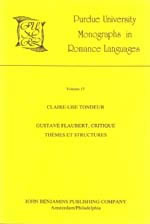 15. Claire-Lise Tondeur: Gustave Flaubert, critique: Thèmes et structures. Amsterdam/Philadelphia: Benjamins, 1984. xiv, 119 pp. Paper.
15. Claire-Lise Tondeur: Gustave Flaubert, critique: Thèmes et structures. Amsterdam/Philadelphia: Benjamins, 1984. xiv, 119 pp. Paper.
"The book is well written and the approach original. The themes and structure which may not be apparent even to the assiduous reader of Flaubert’s letters are clearly brought out and intelligently treated."—Max Aprile
"Tondeur identifies a unifying series of positive/negative oppositions. . . . The case is clearly and persuasively presented."—Forum for Modern Language Studies 23.3 (July 1987): 288.
"Professor Tondeur argues admirably in this study for the coherence of [Flaubert’s] critical thought within his correspondence. . . . Our appreciation of the creative texts written by Flaubert is enriched by Tondeur’s recreation of the esthetic credo to which he adhered in his criticism of writing contemporaneous with his own."—Roland A. Champagne, French Review 61.6 (May 1988): 965-66."Le travail de C.-L. Tondeur offre donc une sorte de lecture souterraine de la Correspondance qui permet d'apercevoir la ‘richesse’ de la critique flaubertienne, trop souvent occultée, et de ‘réfuter le constat d’illogisme de la pensée de Flaubert.’"—Amélie Schweiger, Revue d’Histoire littéraire de la France No. 1 (1988): 142.
For more reviews, see
Romance Quarterly 34 (1987): 497-98. (Meili Steele)
Studi Francesi 32.1 (1988). (Jean-Pierre Baldacci)
Modern Language Review 83.3 (July 1988): 736-37. (R. B. Leal)
French Forum 12.3 (Sept. 1987): 357-58. (Michal Peled Ginsburg)
Les Lettres Romanes 41.4 (1987): 363-65. (Pierre Halen)
Romanische Forschungen 99.1 (1987): 95-97. (Marianne Beyerle)
Nineteenth-Century French Studies 15.4 (Summer 1987): 479-80. (Maryline Lukacher)
Year's Work in Modern Language Studies 47 (1985): 209.
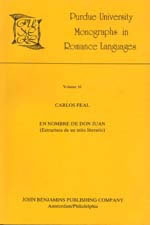 16. Carlos Feal: En nombre de don Juan (Estructura de un mito literario).Amsterdam/Philadelphia: Benjamins, 1984. x, 175 pp. Paper.
16. Carlos Feal: En nombre de don Juan (Estructura de un mito literario).Amsterdam/Philadelphia: Benjamins, 1984. x, 175 pp. Paper.
". . . a powerful and provocative consideration of the questions posed by [the] burlador’s story in its many versions. As such, it demands our attention for being the best kind of book: one that will stimulate further discussions and reconsiderations, all in the name of Don Juan."—James Mandrell, MLN 83.2 (Apr. 1988): 477-78.
". . . a work of remarkable coherence . . . [, it] highlight[s] the interpenetration of literary and social attitudes in the continued potency of the Don Juan myth."—John Macklin, Modern Language Review103.2 (Apr. 1988): 463-66.
"one of the most stimulating books on Spanish literature that I have
read in a long time"—Bruce W. Wardropper
For more reviews, see
Romanische Forschungen 99.2/3 (1987): 307-10. (Brigitte Wittmann)
Romance Quarterly 35 (Feb. 1988): 118-19. (Stephen Miller)
Papers on French Seventeenth Century Literature 16.30 (1989): 287. (James F. Gaines)
Hispania 70.4 (Dec. 1987): 797-98. (Thomas Austin O'Connor)
Hispanic Review 55 (1987): 389-90. (John Dowling)
Year's Work in Modern Language Studies 47 (1985): 343.
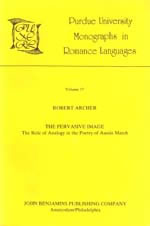 17. Robert Archer: The Pervasive Image: The Role of Analogy in the Poetry of Ausiàs March. Amsterdam/Philadelphia: Benjamins, 1985. xii, 220 pp. Paper.
17. Robert Archer: The Pervasive Image: The Role of Analogy in the Poetry of Ausiàs March. Amsterdam/Philadelphia: Benjamins, 1985. xii, 220 pp. Paper.
". . . a wonderfully illuminating book, whose theoretical rigour and critical sensitivity mark a major shift in the understanding of [March]."—Arthur Terry, Journal of Hispanic Philology 11 (1987): 182-83.
". . . a thorough, precise, logical, and theoretically well-grounded formal study . . ."—Josep Miquel Sobrer, Tenso 3.2 (Spring 19898): 67-68.
". . . an intelligent, close analysis of the main images introduced by our poet, an analysis which reveals a considerable labor of interpretation and classification of the rhetorical devices used. It is, as far as I know, the most complete study in that field ever published."—Lola Badia, Romance Philology 43.1 (Aug. 1989): 220-24.
"In this timely book—a signal milestone in March criticism—Archer evinces the high potential of his impeccable method of analysis, which promises to be an indispensable instrument for future research."—Peter Cocozzella,Romance Quarterly 37.1 (Feb. 1990): 124-25.
For more reviews, see
Llengua & Literatura No. 2 (1987): 521-25.(Lola Badia)
Romanische Forschungen 99.2/3 (1987): 317-19. (Axel Schönberger)
Year's Work in Modern Language Studies 48 (1986): 428.
Medium AEvum 56.2 (1987): 343-44. (Martin J. Duffell)
Hispania 71.1 (Mar. 1988): 75-76. (Kathleen McNerney)
Bulletin of Hispanic Studies 64.4 (Oct. 1987): 391-92. (Catherine Davies)
Speculum (Jan. 1988): 115-17. (Steven Bowman)
British Bulletin of Publications No. 76 (Apr. 1987): 41.
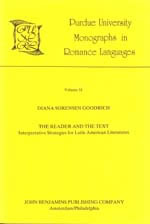 18. Diana Sorensen Goodrich: The Reader and the Text: Interpretative Strategies for Latin American Literatures. Amsterdam/Philadelphia: Benjamins, 1986. xii, 150 pp. Paper
18. Diana Sorensen Goodrich: The Reader and the Text: Interpretative Strategies for Latin American Literatures. Amsterdam/Philadelphia: Benjamins, 1986. xii, 150 pp. Paper
"A remarkable exposition of contemporary literary theory, especially in regards to the general shift in focus from the writer to the reader’s textual decodification." —Floyd Merrell
"[T]he author competently manipulates an impressive array of theoretical modes[,] . . . all of which have something to say about how the reader makes meaning from the text. . . . [This book] will provide satisfying theoretical dialogue and challenging textual commentary." —Stephanie Merrim, Hispania 70.3 (Sept. 1987): 523-25.
". . . a useful handbook for teachers of Latin-American literature wanting to put on courses in the theory and practice of reading."—Jo Labanyi, Bulletin of Hispanic Studies 66 (1989): 194-95.
For more reviews, see
Revista IberoAmericana 54.144-45 (1988): 1063-65. (Monique J. Lemaître)
Chasqui 16.2/3 (Nov. 1987): 102-03. (David William Foster)
British Bulletin of Publications (Oct. 1986): 5.
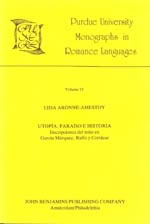 19. Lida Aronne-Amestoy: Utopía, paraíso e historia: inscripciones del mito en García Márquez, Rulfo y Cortázar. Amsterdam/Philadelphia: Benjamins, 1986. xii, 167 pp. Paper.
19. Lida Aronne-Amestoy: Utopía, paraíso e historia: inscripciones del mito en García Márquez, Rulfo y Cortázar. Amsterdam/Philadelphia: Benjamins, 1986. xii, 167 pp. Paper.
"Aronne-Amestoy ha aplicado con rigor y coherencia las formulaciones teóricas en que apoya su análisis. Su libro contribuye a descubrir posibilidades interpretativas y enriquece la lectura de tres autores decisivos en la evolución de nuestra literatura."—Malva E. Filer, Revista Iberoamericana 53.141 (Oct.-Dec. 1987): 1042-45.
". . . contribute[s] . . . a method for the examination of these texts that, in [Aronne-Amestoy’s] hands, has generated fresh, stimulating insights."—Charles A. Piano, World Literature Today, Spring 1987.
"This impressive study examines the role of myth and archetypal configuration in [the three texts], enquiring into the nature of the poetic and cultural processes which mediate historical reality in contemporary Spanish-American fiction."—Robin W. Fiddian, Modern Language Review83.4 (Oct. 1988): 1018.
For more reviews, see
Hispamérica 16.46-47 (1987): 209. (Soledadd Traverso-Rueda)
Revista Canadiense de Estudios Hispanicos 13.3 (Spring 1989). (Rodolfo A. Borello)
Bulletin of Hispanic Studies 66 (1989): 108-09. (Steven Boldy)
Romanische Forschungen 99.2/3 (1987): 315-17. (Wolfgang Matzat)
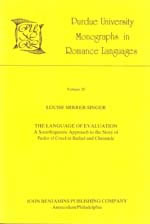 20. Louise Mirrer-Singer: The Language of Evaluation: A Sociolinguistic Approach to the Story of Pedro el Cruel in Ballad and Chronicle.Amsterdam/Philadelphia: Benjamins, 1986. xii, 128 pp. Paper.
20. Louise Mirrer-Singer: The Language of Evaluation: A Sociolinguistic Approach to the Story of Pedro el Cruel in Ballad and Chronicle.Amsterdam/Philadelphia: Benjamins, 1986. xii, 128 pp. Paper.
"Romancero critics . . . have produced some fine pieces of scholarship over the last decade, and M.-S.’s contribution has earned a rightful place among them. . . . her study not only makes intelligent use of a sociolinguistic approach but also suggests a whole new direction for future investigations."—John S. Geary, Romance Philology 44.3 (Feb. 1991): 368-74.
". . . on such questions as the role of tense, negation, and comparison in the structuring of the relationship between performer, protagonist, and audience the analytic chapters are fascinating. . . . a stimulating book."—John Cummins, Modern Language Review 84.1 (Jan. 1989): 200.
". . . here is a book you must read and study. It convincingly resolves linguistic and literary matters heretofore thought without solution and therefore just shrugged off."—Thomas A. Lathrop, Hispania 72 (Mar. 1989): 140.
"a real feather in [PUMRL's] cap"
—Thomas A. Lathrop, Hispania
For more reviews, see
SECOL Review, 14 (1990): 185-86. (Wayne H. Finke)
Medium AEvum 58 (1989): 182-84. (D. G. Pattison)
Le Moyen Âge 95 (1989): 581-83. (Louis Chalon)
Revista de Estudios Hispanicos 23.2 (May 1989): 136-37. (Juan C. Zamora)
Revista Canadiense de Estudios Hispanicos 13.3 (Spring 1989). (Steven N. Dworkin)
Hispanic Review 57 (1989): 365-66. (Joseph Szertics)
Social Sciences Abroad, Series 6 (1988): 75-76.
Zeitschrift für Romanische Philologie 1013.5/6 (1987): 657-58. (Albert Gier)
Bulletin of Hispanic Studies 65.3 (1988): 293-94. (Roger Wright)
La Corónica 16.1 (1987-88): 148-51. (Alessandra Graves)
Forum for Modern Language Studies 23.3 (July 1987): 285-86.
British Bulletin of Publications No. 76 (Apr. 1987).
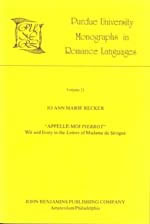
"This is a fresh and lively, yet erudite and . . . critically sophisticated approach to Mme de Sévigné."—David Lee Rubin
"Les exemples donnés . . . et ses brillants commentaires ont vite fait de convaincre le lecteur que Mme de Sévigné n’est pas une femme superficielle et qui gaspillerait son esprit."—Roger Duchêne, Continuum 1.1 (1989): 281-82.
"Cette étude proprement littéraire fournit donc un catalogue riche et détaillé d’un aspect indéniable de la correspondance de Mme de Sévigné."—Mireille Gérard, XVIIe Siècle 39.3 (No. 156) (July-Sept. 1987): 351-52.
Other Reviews:
French Studies 42 (1988): 203 (H. T. Barnwell)
Seventeenth-Century News (Fall-Winter 19889): 51-52.
Cahiers du Dix-Septième 4.1 (Spring 1990): 267-69. (Harriet R. Allentuch)
French Review 62.1 (Oct. 1988): 168-69. (Philip A. Wadsworth)
Studi Francesi 32.1 (1988). (Carla Pellandra)
Papers on French Seventeenth Century Literature 16.30 (19889): 337-38. (Zobeidah Yossef)
Revue d'Histoire Littéraire de la France 89.1 (Jan./Feb. 1989): 101-02. (Chantal Morlet Chantalat)
Zeitschrift für Romanische Philologie 103.5/6 (1987): 638. (Fritz Nies)
Romance Quarterly 36.4 (1989): 489-92, (Henri Mydlarski)
Year's Work in Modern Language Studies 48 (1986): 143.
Forum for Modern Language Studies 23.4 (Oct. 1987): 383.
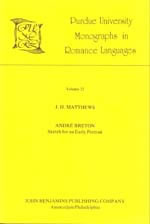 22. J. H. Matthews: André Breton: Sketch for an Early Portrait.Amsterdam/Philadelphia: Benjamins, 1986. xii, 176 pp. Paper.
22. J. H. Matthews: André Breton: Sketch for an Early Portrait.Amsterdam/Philadelphia: Benjamins, 1986. xii, 176 pp. Paper.
". . . an exercise in literary historiography as well as a critical portrait of Breton. . . . [The book] exhibit[s] a shrewd interpretation of the material and a wide knowledge of Surrealist practice."—Willard Bohn
"The author does a good job of convincing us that Breton was not the "petty tyrant" former critics saw in him, but the one person who, at the expense of sacrificing personal friendships, dedicated himself wholeheartedly to keeping the surrealist movement alive."—Susan Detlefsen, Romance Quarterly 37.1 (Feb. 90): 110-11.
"Harry Matthews’s elegant book illuminates as so many of his earlier books have done. . . . And we can thank him for these gentle lessons."—Michael Bishop, French Forum 13.1 (Jan. 1988): 122-23.
"yet another work of magnitude" —Bettina L. Knapp, French Review 62.5 (Apr. 1989): 898-99.
For more reviews, see
French Studies 42.3 (July 1988): 366-67. (Roger Cardinal)
Year's Work in Modern Language Studies 48 (1986): 240.
Forum for Modern Language Studies 23.3 (July 1987): 285.
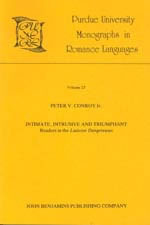 23. Peter V. Conroy, Jr.: Intimate, Intrusive, and Triumphant: Readers in the "Liaisons dangereuses." Amsterdam/Philadelphia: Benjamins, 1987. xii, 139 pp. Paper.
23. Peter V. Conroy, Jr.: Intimate, Intrusive, and Triumphant: Readers in the "Liaisons dangereuses." Amsterdam/Philadelphia: Benjamins, 1987. xii, 139 pp. Paper.
"He draws up a cogent ‘theory of reading’ from the various instructions given by the characters . . . on how letters should be written and read. . . . The analysis of the functions of reading and writing is exhaustive and ingeniously done. . . ."—David Coward, Modern Language Review 85.1 (1990): 190.
"M. Conroy discute avec finesse ces situations où le lecteur n’est pas le destinataire indiqué."—Vivienne Mylne, Revue d’Histoire Littéraire de la France 89.2 (Mar./Apr. 1989): 295.
". . . a refreshingly new monograph . . . a stimulating study . . . "—Paul H. Meyer, French Review 63.4 (Mar. 1990): 711-12.
For more reviews, see
Forum for Modern Language Studies 25.2 (1989): 176.
Modern & Contemporary France No. 36 (Jan. 1989): 46. (Trevor Newland)
Studi Francesi 32.3 (1988): 543. (Regina Bochenek Franczakawa)
French Studies 43.4 (1989): 470-71. (Simon Davies)
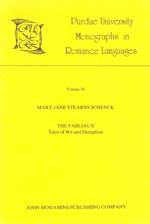 24. Mary Jane Stearns Schenck: The Fabliaux: Tales of Wit and Deception.Amsterdam/Philadelphia: Benjamins, 1987. xiv, 168 pp. Paper.
24. Mary Jane Stearns Schenck: The Fabliaux: Tales of Wit and Deception.Amsterdam/Philadelphia: Benjamins, 1987. xiv, 168 pp. Paper.
"Schenck’s structuralist study of the fabliaux is a pleasingly comprehensible one. . . . It will henceforth be standard reading. . . . "—Keith Busby,Speculum (Jan. 1990): 228-30.
"Schenck argues firmly that fabliau characterization depends . . . on actions . . . and that irony pervades both plot and language. . . . To adapt the last words of Des .III. Dames qui trouverent l’anel . . . , ‘Laquele dont l’anel avoir?’ The answer is, for this reviewer at least, ‘Schenck, n’ait menti. . . . ’"—Brian J. Levy, Medium Ævum 57.2 (1988): 327-29.
For other reviews, see
French Review 62.2 (May 1989): 1071-72. (Harry F. Williams)
French Studies 43.2 (Apr. 1989): 197-98. (Jill Tattersall)
Zeitschrift für Romanische Philologie 104.5/6 (1988): 543-44. (W. Noomen)
Romance Quarterly 36.4 (1989): 486-88. (Robert S. Sturges)
Cahiers de Civilisation Médiévale 35.3 (No. 139) (Dec. 1992): 273-74. (Marie-Thérèse Lorcin)
Year's Work in Modern Language Studies 49 (1987): 70-71.
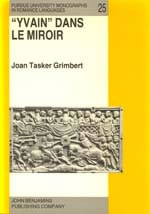 25. Joan Tasker Grimbert: "Yvain" dans le miroir: Une Poétique de la réflexion dans le "Chevalier au lion" de Chrétien de Troyes. Amsterdam/Philadelphia: Benjamins, 1988. xii, 226 pp. Cloth and paper.
25. Joan Tasker Grimbert: "Yvain" dans le miroir: Une Poétique de la réflexion dans le "Chevalier au lion" de Chrétien de Troyes. Amsterdam/Philadelphia: Benjamins, 1988. xii, 226 pp. Cloth and paper.
". . . a stimulating reading of Yvain that could profitably be applied to Chrétien’s other works."—Keith Busby, French Forum 14.3 (Sept. 1989): 351-52.
"In this engagingly written, sensitive and detailed study, Grimbert reflects incisively on how structural and stylistic ambiguities in Chrétien’s masterpiece activate the reader’s own quest for meaning. ‘Yvain’ dans le miroir brings into prominence neglected aspects of this important work while making a useful contribution to the larger problematic of ambiguity in twelfth-century literature."—Donald Maddox
"An excellent account of Chrétien's
crucial narrative of the 12th century …"
—Peter Haidu, Romance Philology 47.3 (Feb. 1994): 367-71.
For more reviews, see
Zeitschrift für französische Sprache un Literatur 101.3 (1991): 3231-22. (Douglas Kelly)
Modern Language Review 86.1 (Jan. 1991): 192-93. (Karen Pratt)
Romance Quarterly 37.4 (1990): 483-84. (Jan A. Nelson)
French Studies 44.4 (1990): 441. (Evelyn Mullally)
French Review 63.2 (1989): 367. (Norris J. Lacy)
Cahiers de Civilisation Médiévale 38.1 (No. 149) (May 1995): 91-93. (Monique Santucci)
Studi Francesi 34.2 (1990). (Anna Maria Compagna Perrone Capano)
Zeitschrift für Romanische Philologie 106.3/4 (1990): 392-94. (Hans R. Runte)
Romanische Forschungen 101.4 (1989): 471-73. (Helen C. R. Laurie)
Forum for Modern Language Studies 25.3 (July 1989): 280.
Medium Aevum 60.1 (1991): 127-28. (Michel Moos)
Speculum 68 (1993): 157-58. (Matilda Tomaryn Bruckner)
Year's Work in Modern Language Studies 50 (1988): 56.
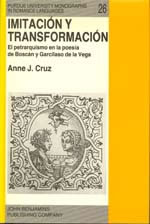 26. Anne J. Cruz: Imitación y transformación: el petrarquismo en la poesía de Boscán y Garcilaso de la Vega. Amsterdam/Philadelphia: Benjamins, 1988. x, 156 pp. Cloth and paper.
26. Anne J. Cruz: Imitación y transformación: el petrarquismo en la poesía de Boscán y Garcilaso de la Vega. Amsterdam/Philadelphia: Benjamins, 1988. x, 156 pp. Cloth and paper.
"There is no doubt as to the author’s excellent preparation and high level of intelligence. She knows Petrarch and Bembo, Boscán and Garcilaso, very well."—Elias L. Rivers
"Cruz’s cogent analyses of the three eclogues . . . are the culmination of her attempt to show the imitation and transformation of the Italianate style in Spain."—David H. Darst, Journal of Hispanic Philology 12.3 (Spring 1988): 257-58.
"... a study that combines a commanding
knowledge of the processes involved in imitation
with a capacity for insightful analysis."
—D. Gareth Walters, Bulletin of Hispanic Studies 68 (1991): 525.
For other reviews, see
Romance Quarterly 38 (1991): 95-106. (Alicia de Colombí-Monguió)
Modern Language R"... a study that combines a commanding knowledge of the processes involved in imitation with a capacity for insightful analysis."—D. Gareth Walters, Bulletin of Hispanic Studies 68 (1991): 525.eview 85 (1990): 1001. (John Gornall)
Revue de Littérature Comparée 3 (1990): 564-65. (Paule Beterous)
Romanische Forschungen 101.2/3 (1989): 366-69. (Mª Pilar Manero Sorolla)
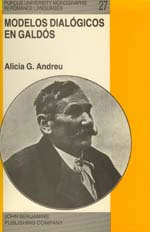 27. Alicia G. Andreu: Modelos dialógicos en la narrativa de Benito Pérez Galdós. Amsterdam/Philadelphia: Benjamins, 1989. xvi, 126 pp. Cloth and paper.
27. Alicia G. Andreu: Modelos dialógicos en la narrativa de Benito Pérez Galdós. Amsterdam/Philadelphia: Benjamins, 1989. xvi, 126 pp. Cloth and paper.
". . . [Andreu's] arguments are cogent and the critical perspective refreshingly different."—Forum for Modern Language Studies 27.1 (1991).
"... aporta a los estudios galdosianos un excelente y meditado análisis crítico de varias novelas de Galdós."—Teresa M. Vilarós, Anales Galdosianos26 (1991): 103-04.
"Andreu’s theoretically informed analyses should challenge other readers to broaden their focus on Galdos’ extraordinary imagination, to meet the challenge of his literary brilliance, in the past too often untapped and unseen."—Noël Valis, Letras Peninsulares (Fall/Winter 1991): 473-75.
For other reviews, see
Bulletin of Hispanic Studies 69.2 (Spring 1992): 203. (Peter Bly)
Romance Quarterly 39.1 (Feb. 1992): 119-21. (Christine Spier)
Modern Language Review 87 (Apr. 1992): 511-13. (Lisa P. Condé)
Zeitschrift für Romanische Philologie 109.1/2 (1993): 234-36. (Karl Hölz)
Year's Work in Modern Language Studies 51 (1989): 343.
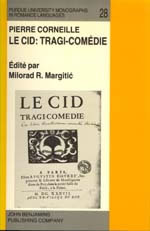 28. Milorad R. Margitic, ed.: Le Cid: Tragi-comédie. By Pierre Corneille. A critical edition. Amsterdam/Philadelphia: Benjamins, 1989. lxxxvi, 302 pp. Cloth and paper.
28. Milorad R. Margitic, ed.: Le Cid: Tragi-comédie. By Pierre Corneille. A critical edition. Amsterdam/Philadelphia: Benjamins, 1989. lxxxvi, 302 pp. Cloth and paper.
"Margitic’s careful erudition in compiling this material is matched by the insight he brings to his introduction. . . . a masterful work, worthy of notre maître Corneille."—Claire Carlin, Papers on French Seventeenth-Century Literature 17.33 (1990): 621-22.
". . . the presentation of Corneille’s original text is not only a distinguished example of text-based scholarship, it also succeeds . . . in setting the play of 1637 against a multi-dimensional literary and cultural background."—W. D. Howarth, French Studies 45.2: 204-05.
For more reviews, see
Revue d'Histoire Littéraire de la France 93.5 (Sept.-Oct. 1993): 734-36. (Georges Forestier)
Revue d'Histoire Littéraire de la France 94.2 (Mar.-Apr. 1994): 284. (Christian Delmas)
Romanische Forschungen 103.2/3 (1991): 301-08. (Hartmut Stenzel)
XVIIe Siècle 42.1 (1990): 113-14 (No. 166) (Alain Couprie)
Rapports / Het Franse Boek 61.3 (1991): 123-25. (Han Verhoeff)
Cahiers du Dix-Septième 3.2 (Fall 1989): 169-70. (Marie-Odile Sweetser)
French Review 65.1 (Oct. 1991): 120-21.(Harriet R. Allentuch)
French Forum 16.2 (May 1991): 233-35. (Antoine Soare)
Studi Francesi 34.3 (1990): 509 (Cecilia Rizza)
Forum for Modern Language Studies 27.1 (1991): 88.
Year's Work in Modern Language Studies 52 (1990): 135.
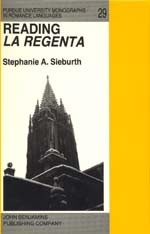 29. Stephanie A. Sieburth: Reading "La Regenta": Duplicitous Discourse and the Entropy of Structure. Amsterdam/Philadelphia: Benjamins, 1990. viii, 127 pp. Cloth and paper.
29. Stephanie A. Sieburth: Reading "La Regenta": Duplicitous Discourse and the Entropy of Structure. Amsterdam/Philadelphia: Benjamins, 1990. viii, 127 pp. Cloth and paper.
"... a well conceived and documented study, written in untypically (considering its deconstructive conclusion) straight-forward prose."—Lou Charnon-Deutsch, Hispania 75 (May 1992): 322-23.
"Indeed, this study is clearly argued, carefully developed, and elegantly written. It is surely one of the best critical assessments of La Regenta that we have."—David Henn, Modern Language Review 87.3 (1992): 779.
"This book is an excellent addition to the now substantial body of (largely North American) critical studies of the self-reflexive dimensions of the Spanish realist novel."—Jo Labanyi, Bulletin of Hispanic Studies 70.2 (1993): 276-77.
"...su lectura me parece casi obligada para quien de ahora en adelante estudie esta obra, por la coherencia con que se logra interpretar la novela de Leopoldo Alas."—Germán Gullón, Romance Quarterly 40.2 (Spring 1993): 125-26.
"[Reading "La Regenta" is] as slimly elegant as it is substantively significant." —John Kronik
For more reviews, see
Revista de Estudios Hispánicos 27.1 (Jan. 1993): 162-63. (Noël Valis)
MLN 108 (1993): 357-60. (Teresa M. Vilarós)
Letras Peninsulares (Winter 1992-93): 467-68. (Thomas R. Franz)
Romanistisches Jahrbuch 43 (1992): 356-59. (Gudrun Wogatzke-Luckow)
Foro Hispánico No. 2 (Nov. 1991): 137-40. (Maarten Steenmeijer)
Revista Hispánica Moderna 44.1 (June 1991): 153-56. (James D. Fernández)
Year’s Work in Modern Language Studies 52 (1990): 347.
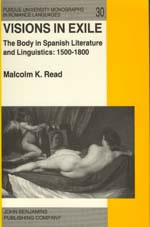 30. Malcolm K. Read: Visions in Exile: The Body in Spanish Literature and Linguistics: 1500-1800. Amsterdam/Philadelphia: Benjamins, 1990. xii, 211 pp. Cloth and paper.
30. Malcolm K. Read: Visions in Exile: The Body in Spanish Literature and Linguistics: 1500-1800. Amsterdam/Philadelphia: Benjamins, 1990. xii, 211 pp. Cloth and paper.
"This brilliant interdisciplinary study serves to situate Spanish thought squarely within the Western tradition—for better or for worse—while calling for ‘re-assessment of our Enlightenment heritage’ with its rationalism run rampant and its ‘denial of the body as language.’"—James Allan Parr,Hispania 74 (Dec. 1991): 886-87.
"... an impeccable work of scholarship...Visions in Exile provides the modern reader with a probing, non-traditional exegesis of three critical centuries of Spanish literary and linguistic history."—Daniel S. Whitaker,Hispanic Review 60 (1992): 343-45.
"... I recommend this interesting and original book to other Hispanists who are ... non-practitioners [of Neo-Freudian criticism]....The author makes thoughtful contributions to literary and linguistic studies...."—Paul Ilie,Bulletin of Hispanic Studies 49 (1992): 281-84.
For more reviews, see
"Once Upon a Body," Rev. Art. by Lou Charnon-Deutsch, Siglo XX/20th Century 30 (1991-92): 209-24.
"New Approaches to Hispanic Letters: The Human Body as Key," Rev. Art. by Nelson R. Orringer, Siglo XX/20th Century 30 (1991-92): 225-38.
Response by Malcolm K. Read, Siglo XX/20th Century 30 (1991-92): 239-46.
Romance Quarterly 39.4 (Nov. 1992): 505-07. (Jesús Pérez-Magallón)
AUMLA (Journal of the Australian Universities Language and Literature Association) No. 78 (Nov. 1992): 137-42. (Alan Soons)
Romanische Forschungen 103.2/3 (1991): 341-42. (Maria Grazia Profeti)
Bibliothèque d’Humanisme et Renaissance [Geneva] 53.2 (1991): 490-91. (L. R. N. Ashley)
XVIIe Siècle No. 171; Seventeenth-Century News 43.2 (June 1991): 197-98. (Raphaël Carrasco)
Year’s Work in Modern Language Studies 52 (1990): 277.
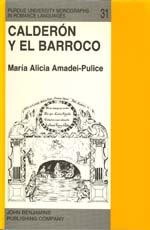 31. María Alicia Amadei-Pulice: Calderón y el Barroco: exaltación y engaño de los sentidos. Amsterdam/Philadelphia: Benjamins, 1990. xii, 258 pp. 33 ills. Cloth and paper.
31. María Alicia Amadei-Pulice: Calderón y el Barroco: exaltación y engaño de los sentidos. Amsterdam/Philadelphia: Benjamins, 1990. xii, 258 pp. 33 ills. Cloth and paper.
"... a valuabale study which enables us to appreciate much more fully the dramatic artistry of Calderón in the context of a clear view of differences between the Renaissance comedia and the polytechnic advances of its Baroque successor."—James A. Castañeda, Hispania 75.3 (Sept. 1992): 558-59.
"In this well-written book, Amadei–Pulice employs critical sophistication and depth of knowledge about important issues concerning Spanish Golden Age drama and its evolution from the comedia nueva of Lope de Vega to the baroque theatre of Calderón de la Barca."—Teresa S. Soufas, Bulletin of the Comediantes 44.1 (Summer 1992): 167-69.
"... a book which combines solid scholarship with some interesting readings of an impressive number of dramatic texts to provide an important addition to our understanding of Calderón."—Grace M. Burton, Romance Quarterly40.1 (Winter 1993): 61-62.
For more reviews, see
Criticón 55 (1992): 176-79. (Ignacio Arellano)
Hispanic Review 61 (Spring 1993): 282-84. (Robert ter-Horst)
Quaderni Ibero-Americani ciclo 18, 9.69-70 (June-Dec. 1991): 350.
Year’s Work in Modern Language Studies 52 (1990): 338.
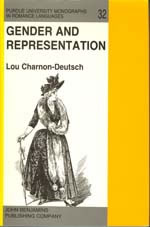 32. Lou Charnon-Deutsch: Gender and Representation: Women in Spanish Realist Fiction. Amsterdam/Philadelphia: Benjamins, 1990. xiv, 205 pp. 6 ills. Cloth and paper.
32. Lou Charnon-Deutsch: Gender and Representation: Women in Spanish Realist Fiction. Amsterdam/Philadelphia: Benjamins, 1990. xiv, 205 pp. 6 ills. Cloth and paper.
"In Gender and Representation the voiceless ‘other’ of Spanish realist fiction speaks at last."—Marsha S. Collins, Anales Galdosianos (1996): 211-12.
"This is a seminal work, in the sense that it is bursting with new approaches that are not always worked through to a conclusion, but which leave enormous scope for future critics."—Jo Labanyi, Bulletin of Hispanic Studies 72 (1995): 132-34.
"Lou Charnon-Deutsch demonstrates that she has only just begun to lift the lid off an enormous area ripe for revaluation."—Alison Sinclair, Modern Language Review 87.1 (Oct. 1992): 1012-13.
"Gender and Representation is an intelligent, insightful discussion of nineteenth-century fiction that should serve as a catalyst for future work in the field."—Phyllis Zatlin, Letras Peninsulares (Fall 1992): 305-06.
"This is an extremely worthwhile book."
—Noël Valis, Hispania
For more reviews, see
Romance Quarterly 41.1 (Winter 1994): 51-52. (James Whiston)
Hispanófila No. 106 (Sept. 1992): 69-71. (Janet Pérez)
Revista Canadiense de Estudios Hispánicos 17.3 (1993): 571-76.
Hispanic Review 61 (1993): 106-08. (Beth Wietelmann Bauer)
Tulsa Studies in Women’s Literature 11.2 (Fall 1992): 371-73.(James D. Fernández)
Hispania 75.1 (1990): 93-94. (Noël Valis)
Forum for Modern Language Studies 28.3 (July 1992): 282.
Year’s Work in Modern Language Studies 52 (1990): 346.
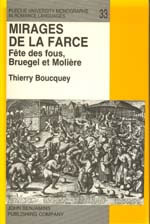 33. Thierry Boucquey: Mirages de la farce: Fête des fous, Bruegel et Molière.Amsterdam/Philadelphia: Benjamins, 1991. xviii, 145 pp. 9 ills. Cloth and paper.
33. Thierry Boucquey: Mirages de la farce: Fête des fous, Bruegel et Molière.Amsterdam/Philadelphia: Benjamins, 1991. xviii, 145 pp. 9 ills. Cloth and paper.
"L’excellente étude de Thierry Boucquey se range dans cette catégorie d’ouvrages [qui ont le mérite non négligeable d’effectuer la synthèse d’éléments provenant de la même tradition culturelle et littéraire]."—Léonard Rosmarin, French Review 66.3 (Feb. 1993): 491-92.
"In its bold initiative to put painting and drama under the same methodological sign, and in its convincing theoretical framework, Boucquey"s study is a valuable addition to scholarship and throws new light on a singularly elusive form."—Harold C. Knutson, Papers in French Seventeenth-Century Literature 19.36 (1992): 213-14.
For more reviews, see
Forum for Modern Language Studies 30.4 (1994).
Modern Language Review 88.2 (1993): 465-66. (Maya Slater)
Romanische Forschungen 104.3/4 (1992): 458-60. (Konrad Schoell)
French Forum 17.3 (Sept. 1992): 337-39. (Barbara C. Bowen)
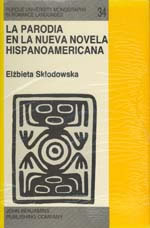 34. Elzbieta Sklodowska: La parodia en la nueva novela hispanoamericana (1960-1985). Amsterdam/Philadelphia: Benjamins, 1991. xx, 219 pp. Cloth and paper.
34. Elzbieta Sklodowska: La parodia en la nueva novela hispanoamericana (1960-1985). Amsterdam/Philadelphia: Benjamins, 1991. xx, 219 pp. Cloth and paper.
"Esta obra, cuidadosamente elaborada, de Elzbieta Sklodowska presenta un brillante examen de la práctica paródica en la nueva novela hispanoamericana."—Anjouli Janzon, Revista de Crítica Literaria Latinoamericana 23.43/44 (1996): 352-53.
"...formidably well researched in its theoretical aspect ...this stimulating study will surely serve as a point of departure for further investigations on the theme of parody in the volatile field of the Spanish-American novel."—Norman Cheadle, Revista Canadiense de Estudios Hispánicos 17.2 (1993): 413-14.
"... while the study aims to explore parody as a constitutive element in recent Spanish American narrative, the book's organization implicitly proposes how to make sense of—or how to begin to tell the story of—recent developments in the new novel."—Lucille Kerr, Revista de Estudios Hispánicos 27.2 (May 1993): 328-29.
"The author gives an excellent account of the role that parody plays in the postmodern narrative and in the post-Boom generaton of Latin-American novelists."—Antonio Fama, Modern Language Review 88.1 (Jan. 1993): 245-56.
For more reviews, see
Nueva Revista de Filología Hispánica 41 (1993): 603-07. (Jorge Fornet)
Hispanic Review 61 (Spring 1993): 316-17. (Donald L. Shaw)
Hispania 76.2 (May 1993): 293-94. (George R. McMurray)
World Literature Today 67.1 (Winter 1993): 161. (Brian Evenson)
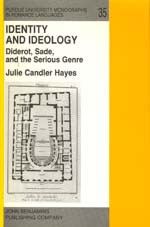 35. Julie Candler Hayes: Identity and Ideology: Diderot, Sade, and the Serious Genre. Amsterdam/Philadelphia: Benjamins, 1991. xiv, 186 pp. Cloth and paper.
35. Julie Candler Hayes: Identity and Ideology: Diderot, Sade, and the Serious Genre. Amsterdam/Philadelphia: Benjamins, 1991. xiv, 186 pp. Cloth and paper.
"Only examination of the total spectrum of the drame ... can produce a genuine rehabilitation of the genre, to which this study contributes an admirable point of departure."—Josephine Grieder, French Review 67.3 (Feb. 1994): 518-19.
"[Hayes ’s] book is well written, closely argued, and scrupulously edited, ..."—Michael Cardy, Modern Language Review 88.4 (1993): 903-04.
For more reviews, see
Romance Quarterly 41.2 (Spring 1994): 120. (Marie Wellington)
Revue d’Histoire Littéraire de la France 94.2 (Mar.-Apr. 1994): 325. (Michel Delon)
Dix-Huitième Siècle No. 25 (1993). (M. de Rougemont)
Forum for Modern Language Studies 29.2 (Apr. 1993): 181.
Year’s Work in Modern Language Studies 53 (1991): 158.
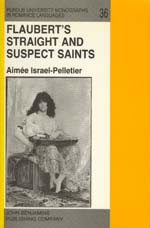 36. Aimée Israel-Pelletier: Flaubert’s Straight and Suspect Saints: The Unity of "Trois contes." Amsterdam/Philadelphia: Benjamins, 1991. xii, 165 pp. Cloth and paper.
36. Aimée Israel-Pelletier: Flaubert’s Straight and Suspect Saints: The Unity of "Trois contes." Amsterdam/Philadelphia: Benjamins, 1991. xii, 165 pp. Cloth and paper.
"... an impressive book ... a very good book that critics of Flaubert and nineteenth-century scholars will want to read."—Doris Y. Kadish, French Review 67.4 (Mar. 1994): 688-89.
"Despite its fashionably slim appearance..., Flaubert's Straight and Suspect Saints offers an eclectic yet impressive array of critical insights, detailed textual analysis of a high order and thoughtful historical commentary on the meaning of Flaubert's last completed work. Its subtle and persuasive interpretations challenge us to do nothing less than rethink the way we read Flaubert"—Susan L. Wolf, Nineteenth-Century French Studies 21.3/4 (Spring/Summer 1993): 506-08.
For more reviews, see
Studi Francesi 37.2 (1993). (Jean-Pierre Baldacci)
Forum for Modern Language Studies 29.2 (Apr. 1993): 181-82.
Year’s Work in Modern Language Studies 53 (1991): 196.
 37. Susan Petit: Michel Tournier’s Metaphysical Fictions.Amsterdam/Philadelphia: Benjamins, 1991. xvi, 224 pp. Cloth and paper.
37. Susan Petit: Michel Tournier’s Metaphysical Fictions.Amsterdam/Philadelphia: Benjamins, 1991. xvi, 224 pp. Cloth and paper.
"... Petit provides an articulate, informed, and cohesive view of Tournier’s intent and product which is essential reading for all persons concerned with contemporary French literature and culture."—Katherine C. Kurk, French Review 68.5 (Apr. 1995): 883-84.
"... recommended as a useful initiation to Tournier’s work as a whole, and as an illuminating study of its religious dimension in particular."—Mairi Maclean, Modern Language Review 89.2 (1994): 500-01.
"... provocative enough to ensure that her stated hope in writing it—to help readers join in the creative act by reflecting on Tournier’s work, will indeed be realized."—Lorna Milne, Modern Fiction Studies 38.4 (1993): 975-76.
"... a very welcome addition in English to analysis guided by Tournier’s essays, interviews and autobiography."—Christopher Anderson, SubStance71/72 (1993): 364-66.
For more reviews, see
Revue des Sciences Humaines No. 232 (1993-94): 154.
Revue d’Histoire Littéraire de la France 93.2 (Mar.-Apr. 1993): 304-05. (Jean-Michel Maulpoix)
Studi Francesi 37.3 (1993). (Roberta Rampone)
Forum for Modern Language Studies 29.2 (Apr. 1993): 187.
French Studies 37.2 (1992-93): 240-41. (Colin Davis)
Choice 30.1 (Sept. 1992): 122. (F. C. St. Aubyn)
Reference & Research Book News (Dec. 1992): 31.
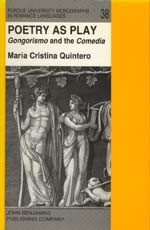 38. Maria Cristina Quintero: Poetry as Play: "Gongorismo" and the "Comedia."Amsterdam/Philadelphia: Benjamins, 1991. xviii, 260 pp. Cloth and paper.
38. Maria Cristina Quintero: Poetry as Play: "Gongorismo" and the "Comedia."Amsterdam/Philadelphia: Benjamins, 1991. xviii, 260 pp. Cloth and paper.
"Poetry as Play ... will not be the last word on the subject of Gongorismo and the ‘Comedia,’ but it will be the benchmark from which subsequent inquiries will take their measure, and it will be an invaluable resource for those who wish to substantially enrich their classes and seminars on the Golden Age."— C. George Peale, Symposium 47.1 (Spring 1993): 78-80.
"Poetry as Play is a genuine pleasure to read;... Both specialist andamateur alike will delight in the careful research and the judicious interplay of text and critical theory that mark this intelligent delineation ofgongorismo in the comedia."—K. M. Sibbald, Revista Canadiense de Estudios Hispánicos 18.2 (Winter 1994): 364-66.
"This is a well-written and informative book that delves deeply into the connection between poetry and drama."—Frederick A. de Armas, Bulletin of Hispanic Studies 71.2 (Apr. 1994): 265-66.
"... this is by far the most exhaustive study to date of Gongorine language in the comedia and, indeed, of poetic practice in general in that genre. ... it is an essential book for specialists ... and belongs in any library serving undergraduate major and graduate programs in Spanish."—J. A. Parr,Choice 30.1 (Sept. 1992): 122.
"...the book is beautifully organized and makes its points tellingly. It will and ought to set all Golden Age specialists to re-thinking our basic notions about the bast non-prose literary production that we study."—David J. Hildner, Hispanic Review 63 (1995): 95-96.
For more reviews, see
Hispanófila No. 113 (Jan. 1995): 85-86. (Jorge Checa)
Bulletin of the Comediantes 44.2 (Winter 1992): 279-81. (Marsha S. Collins)
Gestos 10.19 (Apr. 1995): 232-33. (Emilie L. Bergmann)
Hispania 75.5 (Dec. 1992): 1179. (Ted E. McVay, Jr.)
Criticón 55 (1992): 172-75. (Ignacio Arellano)
Reference & Research Book News (Dec. 1992): 32.
British Bulletin of Publications (1993).
Year’s Work in Modern Language Studies 53 (1991): 324.
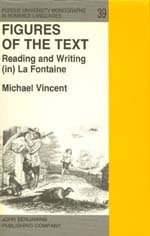 39. Michael Vincent: Figures of the Text: Reading and Writing (in) La Fontaine. Amsterdam/Philadelphia: Benjamins, 1992. xiv, 154 pp. Cloth and paper.
39. Michael Vincent: Figures of the Text: Reading and Writing (in) La Fontaine. Amsterdam/Philadelphia: Benjamins, 1992. xiv, 154 pp. Cloth and paper.
"Vincent has indeed lifted a corner of the veil with which La Fontaine carefully draped his work."—Roseann Runte, French Review 68.3 (Feb. 1995): 525-26.
"I was often sorry to come to the end of a chapter in this book, since the exploration in it had been so rewarding with Vincent as skillful guide."—Terence Allott, Modern Language Review 89.3 (1994): 769.
"...rewarding reading. ... his observations cast new light not only on La Fontaine but more generally on words and concepts which exercised the seventeenth-century mind."—Maya Slater, French Studies 48.1 (Jan. 1994): 95-96.
"ce volume élégamment
concis mais dense"—Jean-Pierre
Collinet, XVIIe Siècle
For more reviews, see
Forum for Modern Language Studies 8.1 (1994): 191.
Romanische Forschungen 105.3/4 (1993): 443-44. (Jean-Pierre Collinet)
XVIIe Siècle No. 182 (Jan-Mar. 1996): 204. (Jean-Pierre Collinet)
Studi Francesi 37.2 (1993). (Jean-Pierre Collinet)
Revue d’Histoire Littéraire de la France 94.2 (Mar.-Apr. 1994): 289-90. (Jean-Pierre Collinet)
Zeitschrift für französische Sprache u. Literatur 103.2 (1993): 210-12. (Hermann Lindner)
Papers in French Seventeenth Century Literature 20.39 (1993): 587-88. (Éva Pósfay)
Year’s Work in Modern Language Studies (1992): 104.
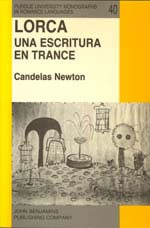 40. Candelas Newton: Lorca, una escritura en trance: "Libro de poemas" y "Diván del Tamarit." Amsterdam/Philadelphia: Benjamins, 1992. x, 249 pp. Cloth and paper.
40. Candelas Newton: Lorca, una escritura en trance: "Libro de poemas" y "Diván del Tamarit." Amsterdam/Philadelphia: Benjamins, 1992. x, 249 pp. Cloth and paper.
"The extraordinary coherence of Lorca's writing ... is the subject of this study of his early and late poems. ... this book makes a really substantial contribution to the study of Lorca's poetry."—Derek Harris, Bulletin of Hispanic Studies 71 (1994): 417.
"Es este un libro de obligada lectura para los estudiosos de Lorca, cuyas enseñanzas trascienden la meta impuesta, ya que el análisis de las dos colecciones poéticas ilumina la obra total del poeta."—Antonio F. Cao,Hispanic Review 62.3 (Summer 1994): 443-45.
"...this is a solidly written and argued book that all committed students of Lorca's poetry will need to take on board."—Andrew A. Anderson, Revista Canadiense de Estudios Hispánicos 18.1 (Fall 1993): 122-24.
For more reviews, see
Forum for Modern Language Studies 8.1 (1994): 187.
Revista de Estudios Hispánicos 28.1 (Jan. 1994): 128-30. (Salvatore Poeta)
Quaderni Ibero-Americani, ciclo 18, 9.72 (Dec. 1992): 766.
Year’s Work in Modern Language Studies (1992): 336.
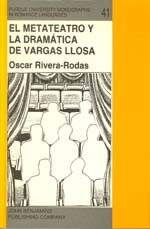 41. Oscar Rivera-Rodas: El metateatro y la dramática de Vargas Llosa: hacia una poética del espectador. Amsterdam/Philadelphia: Benjamins, 1992. viii, 213 pp. Cloth and paper.
41. Oscar Rivera-Rodas: El metateatro y la dramática de Vargas Llosa: hacia una poética del espectador. Amsterdam/Philadelphia: Benjamins, 1992. viii, 213 pp. Cloth and paper.
"This is an extremely detailed and thorough reading of Vargas Llosa's plays, as well as a theory of metatheater."—Raymond Lesllie Williams, Hispanic Review 63 (1995): 254-55.
"...an impressive theoretical work that uses the Peruvian's plays as evidence." —Peter Beardsell, Modern Language Review 89.3 (1994): 790-91.
"...this book is thought-provoking and opens the door for future investigation into related areas."—Jean O'Bryan, Revista de Estudios Hispánicos 28.3 (Oct. 1994): 472-73.
"...el perspicaz examen de la función del lector/espectador en la producción del metateatro y el cuidadoso análisis del teatro vargas-llosiano hacen la lectura de este texto imprescindible para todo el que se interese en el teatro latinoamericano contemporáneo." —María A. Salgado, HispanófilaNo. 115 (Sept. 1995): 84-85.
For more reviews, see
Romanische Forschungen 107.1/2 (1995): 274-75. (Sabine Giersberg)
Notas 2.1 (1995): 100-02. (Sabine Schlickers)
Revista Interamericana de Bibliografía 42.4 (1992): 661-62. (Juan Villegas)
Year’s Work in Modern Language Studies (1992): 405.
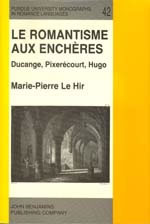 42. Marie-Pierre Le Hir: Le Romantisme aux enchères: Ducange, Pixerécourt, Hugo. Amsterdam/Philadelphia: Benjamins, 1992. x, 225 pp. Cloth and paper.
42. Marie-Pierre Le Hir: Le Romantisme aux enchères: Ducange, Pixerécourt, Hugo. Amsterdam/Philadelphia: Benjamins, 1992. x, 225 pp. Cloth and paper.
"[the book] has many valuable points to make with regard to the cultural politics of the period...."—Forum for Modern Language Studies 30.1 (1994): 88.
"... ce travail fort bien documenté"—Fernande Bassan, Nineteenth-Century French Studies 22.3-4 (Spring-Summer 1994): 604-05.
For more reviews, see
Year’s Work in Modern Language Studies (1992): 175-76.
Actes de la Recherche en Sciences Sociales 111.1 (1996):130-31. (Marie-Claire Pottier)
